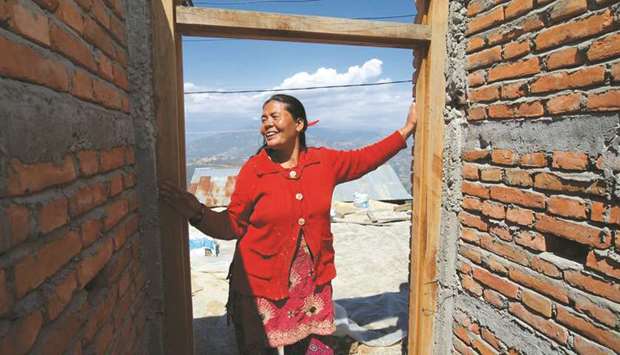Her home had been destroyed by the 2015 earthquake, which claimed close to 9,000 lives and left hundreds of thousands of people homeless.
When disaster struck, Phulsani’s husband was working in Saudi Arabia and the other men in her village were too busy rebuilding their own homes to help.
“At that time, it was hard to even find someone to build a cowshed … it was so frustrating,” she says.
So Phulsani decided to build a house herself.
She and nine other women in Baluwapati, a village a few hours’ drive outside the capital Kathmandu, signed up for a training course to become stonemasons. In deeply traditional rural Nepal, this was a radical step, and the reaction from the men in the village was predictable.
“They said, ‘You are women so you can’t do it and you shouldn’t be doing it,’” says Phulsani.
But 12 months on, with eight houses under her belt, things have changed. “Now the men walk by quietly when they see us working. They don’t dare to make negative comments.”
Nepal’s efforts to recover from the 2015 earthquake, which destroyed more than half a million homes, have been hampered by political upheaval and bureaucratic hurdles, but also by a lack of trained builders.
To address the shortage, the Swiss development agency Helvetas, with funding from the UK’s Department for International Development (DfID), has trained 6,500 masons, a third of whom are women.
“The training has given these women much more confidence. Now they believe they can do any kind of work, not just house building. They have more income, which they often spend on their children’s education, and they are no longer dependent on their husbands,” says Kriti Bhuju, a programme officer at Helvetas.
And a recent study by the Housing Recovery and Reconstruction Platform, a forum for all bodies involved in earthquake reconstruction, found that of the women they spoke to who had trained as masons, only half were working at the trade.
“Some women who have done the training have had a positive experience, but many can’t find employment. Some are not trusted to do the work and others are paid less than men,” says Siobhan Kennedy, recovery adviser at HRRP.
Three years after the earthquake, reconstruction efforts are patchy at best. While building has accelerated in the past year, much of this has been prompted by government deadlines to claim reconstruction grants. These are disbursed only after homeowners can prove they have built property to a prescribed level, resulting in many small, impractical buildings in the rush to meet the deadlines.
The scene in Baluwapati is typical. Along the steep terraced slopes stand the cracked remains of traditional stone houses alongside temporary earthquake shelters built from bamboo and metal sheets. Among them are new, earthquake-resistant brick homes; some still at the foundation stage and others completed.
Pride of place among the new buildings is the two-storey local administrative office, built by women, including Ranjana Tamang.
“Some people complained that it would take women two months to build it, but we finished it on schedule in a month,” she says. “People acknowledge that we are capable now, even if they do not specifically praise us.”
Because of her building work, Ranjana is earning an income for the first time – about £6 a day. “I used to be totally dependent on my husband’s money, but now I can contribute to the children’s expenses. I can stand on my own feet.”
Sharmila Tamang has become a contractor, overseeing the building of 12 houses, with three more under way. “I do contracted work as if I was building my own house. People say I work hard. We women have become the first choice for building a house in the village,” she says.
Like many villages across Nepal, Baluwapati is short of men. Scores have left to find work in Kathmandu or abroad, but Sharmila says this is not the main reason women have turned to construction.
“Men don’t like to do hard work. Building houses is difficult. So they didn’t want to do that training. Also men drink and create problems, but women work well together,” she says.
But in places like Baluwapati, female builders are still expected to keep up with their traditional jobs; housework, farming and childcare. Sharmila’s response is typically entrepreneurial: “If I don’t have time to do the housework, I pay another woman a small amount to do it for me.”
Sharmila’s husband, Jeet Bahadur Tamang, appears supportive. “Whatever they’ve done so far is good. The buildings they made haven’t come down yet. Women do everything
nowadays,” he says.



